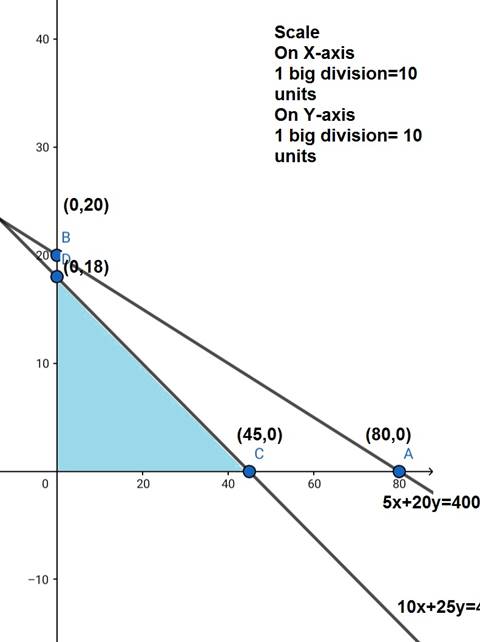A furniture manufacturing company plans to make two products : chairs and tables. From its available resources which consists of 400 square feet of teak wood and 450 man hours. It is known that to make a chair requires 5 square feet of wood and 10 man - hours and yields a profit of ₹ 45, while each table uses 20 square feet of wood and 25 man - hours and yields a profit of ₹ 80. How many items of each product should be produced by the company so that the profit is maximum?
Let required production of chairs and tables be x and y respectively.
Since, profits of each chair and table is Rs. 45 and Rs. 80 respectively. So, profits on x number of type A and y number of type B are 45x and 80y respectively.
Let Z denotes total output daily, so,
Z = 45x + 80y
Since, each chair and table requires 5 sq. ft and 80 sq. ft of wood respectively. So, x number of chair and y number of table require 5x and 80y sq. ft of wood respectively. But,
But 400 sq. ft of wood is available. So,
5x + 80y ![]() 400
400
x + 4y ![]() 80 {First Constraint}
80 {First Constraint}
Since, each chair and table requires 10 and 25 men - hours respectively. So, x number of chair and y number of table require 10x and 25y men - hours respectively. But, only 450 hours are available . So,
10x + 25y ![]() 450
450
2x + 5y ![]() 90 {Second Constraint}
90 {Second Constraint}
Hence mathematical formulation of the given LPP is,
Max Z = 45x + 80y
Subject to constraints,
x + 4y ![]() 80
80
2x + 5y ![]() 90
90
x,y ![]() 0 [Since production of chairs and tables can not be less than zero]
0 [Since production of chairs and tables can not be less than zero]
Region x + 4y ![]() 80: line x + 4y = 80 meets the axes at A(80,0), B(0,20) respectively.
80: line x + 4y = 80 meets the axes at A(80,0), B(0,20) respectively.
Region containing the origin represents x + 4y ![]() 80 as origin satisfies x + 4y
80 as origin satisfies x + 4y ![]() 80
80
Region 2x + 5y ![]() 90: line 2x + 5y = 90 meets the axes at C(45,0), D(0,20) respectively.
90: line 2x + 5y = 90 meets the axes at C(45,0), D(0,20) respectively.
Region containing the origin represents 2x + 5y ![]() 90
90
as origin satisfies 2x + 5y ![]() 90
90
Region x,y ![]() 0: it represents the first quadrant.
0: it represents the first quadrant.

The corner points are O(0,0), D(0,18), C(45,0).
The values of Z at these corner points are as follows:

The maximum value of Z is 2025 which is attained at C(45,0).
Thus maximum profit of Rs 2025 is obtained when 45 units of chairs and no units of tables are produced.